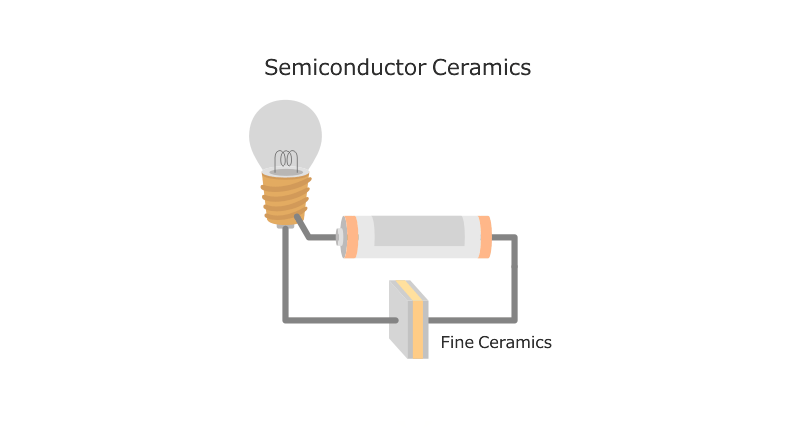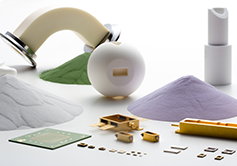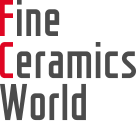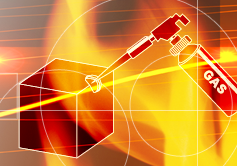Fine Ceramics, sometimes referred to as "advanced ceramics," are engineered materials that support the development of cutting-edge technology.
Electricity and Magnetism (2)
Conductivity to Allow Electricity to Pass Through
Though Fine Ceramics (also known as "advanced ceramics") are generally insulating materials that block electricity, semiconductor ceramics can be created to conduct electricity depending on their temperature and the level of voltage applied.

Applications: Temperature sensors, temperature measuring devices and solid oxide fuel cell.
Description
Conductivity
Conductivity is a property that allows electricity to flow through a material. Fine Ceramics are insulating materials in general, but some varieties exhibit electrical conductivity according to changes in temperature.
A thermistor is an electronic component utilizing a property in which electrical resistance decreases as temperature increases, allowing electricity to flow more easily when the material gets hot. These devices are used in sensors that monitor temperature changes and in equipment designed to prevent electronics from overheating. A varistor is a similar component that possesses a property in which resistance decreases as voltage increases. Varistors are used to protect electronic circuits from excessive voltages.
The term "Fine Ceramics" is interchangeable with "advanced ceramics," "technical ceramics" and "engineered ceramics." Use varies by region and industry.
People who read this page also read.

Electricity and Magnetism (1)
Electricity and Magnetism (1)
Electrical Insulation to Inhibit Electricity from Passing Through
Electrical Insulation to Inhibit Electricity from Passing Through
Characteristics of Fine Ceramics

Electricity and Magnetism (3)
Electricity and Magnetism (3)
Dielectricity to Accumulate Electricity
Dielectricity to Accumulate Electricity
Characteristics of Fine Ceramics

Electricity and Magnetism (4)
Electricity and Magnetism (4)
Piezoelectricity to Convert Electricity into Power/Power into Electricity
Piezoelectricity to Convert Electricity into Power/Power into Electricity
Characteristics of Fine Ceramics

Electricity and Magnetism (5)
Electricity and Magnetism (5)
Magnetism to Hold Magnetic Force
Magnetism to Hold Magnetic Force
Characteristics of Fine Ceramics

Different Types of Fine Ceramics
Different Types of Fine Ceramics
Wide Variety of Products to Support both Industry and Society
Wide Variety of Products to Support both Industry and Society
Introduction to Fine Ceramics
If you want to use ceramics in business, click here.
Kyocera's Fine Ceramics products (All websites below open in a separate window.)
Product Category
 Semiconductor / LCD Processing Equipment
Semiconductor / LCD Processing Equipment
 Life / Culture / Industrial Machines
Life / Culture / Industrial Machines
 Wireless Communications
Wireless Communications
 Computer Peripherals
Computer Peripherals
 Environmental Preservation / Renewable Energy
Environmental Preservation / Renewable Energy
 Medical Equipment / Devices
Medical Equipment / Devices
 Single-Crystal Sapphire Products
Single-Crystal Sapphire Products
 Metallized / Vacuum Components
Metallized / Vacuum Components
 Electronics Industry
Electronics Industry
 Heaters
Heaters
 Piezoelectric Ceramics
Piezoelectric Ceramics
Search by Material
 Alumina
Alumina
 Silicon Nitride
Silicon Nitride
 Silicon Carbide
Silicon Carbide
 Sapphire
Sapphire
 Zirconia
Zirconia
 Cordierite
Cordierite
 Yttria
Yttria
 Aluminum Nitride
Aluminum Nitride
 Cermet
Cermet
 Mullite
Mullite
 Steatite
Steatite
 Forsterite
Forsterite
Search by Property/Characteristic


- Thermal Properties
- Coefficient of Thermal Expansion
- Thermal Conductivity
- Heat Shock Resistance

- Electrical Properties
- Insulation / Semiconductivity

- Chemical Properties
- Chemical Resistance










